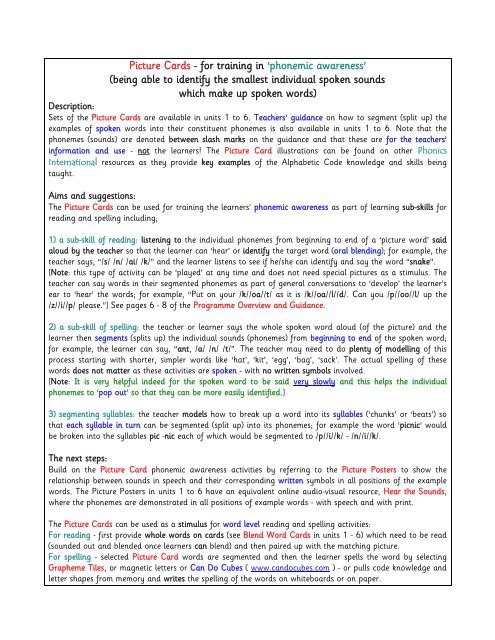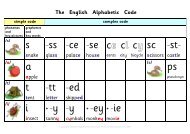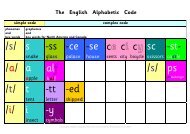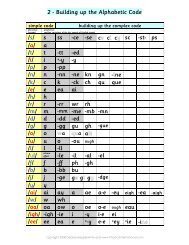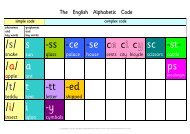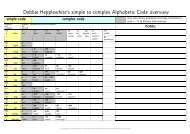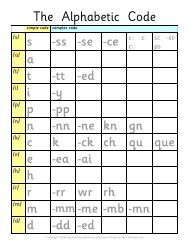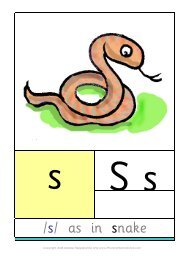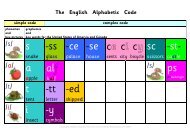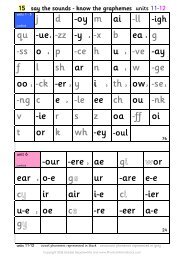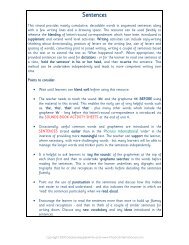Letters, Sounds and Pictures Matching Game - Phonics International
Letters, Sounds and Pictures Matching Game - Phonics International
Letters, Sounds and Pictures Matching Game - Phonics International
- No tags were found...
You also want an ePaper? Increase the reach of your titles
YUMPU automatically turns print PDFs into web optimized ePapers that Google loves.
Picture Cards - for training in ‘phonemic awareness’<br />
(being able to identify the smallest individual spoken sounds<br />
which make up spoken words)<br />
Description:<br />
Sets of the Picture Cards are available in units 1 to 6. Teachers’ guidance on how to segment (split up) the<br />
examples of spoken words into their constituent phonemes is also available in units 1 to 6. Note that the<br />
phonemes (sounds) are denoted between slash marks on the guidance <strong>and</strong> that these are for the teachers’<br />
information <strong>and</strong> use - not the learners! The Picture Card illustrations can be found on other <strong>Phonics</strong><br />
<strong>International</strong> resources as they provide key examples of the Alphabetic Code knowledge <strong>and</strong> skills being<br />
taught.<br />
Aims <strong>and</strong> suggestions:<br />
The Picture Cards can be used for training the learners’ phonemic awareness as part of learning sub-skills for<br />
reading <strong>and</strong> spelling including;<br />
1) a sub-skill of reading: listening to the individual phonemes from beginning to end of a ‘picture word’ said<br />
aloud by the teacher so that the learner can ‘hear’ or identify the target word (oral blending); for example, the<br />
teacher says, “/s/ /n/ /ai/ /k/” <strong>and</strong> the learner listens to see if he/she can identify <strong>and</strong> say the word “snake”.<br />
[Note: this type of activity can be ‘played’ at any time <strong>and</strong> does not need special pictures as a stimulus. The<br />
teacher can say words in their segmented phonemes as part of general conversations to ‘develop’ the learner’s<br />
ear to ‘hear’ the words; for example, “Put on your /k//oa//t/ as it is /k//oa//l//d/. Can you /p//oo//l/ up the<br />
/z//i//p/ please.”] See pages 6 - 8 of the Programme Overview <strong>and</strong> Guidance.<br />
2) a sub-skill of spelling: the teacher or learner says the whole spoken word aloud (of the picture) <strong>and</strong> the<br />
learner then segments (splits up) the individual sounds (phonemes) from beginning to end of the spoken word;<br />
for example, the learner can say, “ant, /a/ /n/ /t/”. The teacher may need to do plenty of modelling of this<br />
process starting with shorter, simpler words like ‘hat’, ‘kit’, ‘egg’, ‘bag’, ‘sack’. The actual spelling of these<br />
words does not matter as these activities are spoken - with no written symbols involved.<br />
[Note: It is very helpful indeed for the spoken word to be said very slowly <strong>and</strong> this helps the individual<br />
phonemes to ‘pop out’ so that they can be more easily identified.]<br />
3) segmenting syllables: the teacher models how to break up a word into its syllables (‘chunks’ or ‘beats’) so<br />
that each syllable in turn can be segmented (split up) into its phonemes; for example the word ‘picnic’ would<br />
be broken into the syllables pic -nic each of which would be segmented to /p//i//k/ - /n//i//k/.<br />
The next steps:<br />
Build on the Picture Card phonemic awareness activities by referring to the Picture Posters to show the<br />
relationship between sounds in speech <strong>and</strong> their corresponding written symbols in all positions of the example<br />
words. The Picture Posters in units 1 to 6 have an equivalent online audio-visual resource, Hear the <strong>Sounds</strong>,<br />
where the phonemes are demonstrated in all positions of example words - with speech <strong>and</strong> with print.<br />
The Picture Cards can be used as a stimulus for word level reading <strong>and</strong> spelling activities:<br />
For reading - first provide whole words on cards (see Blend Word Cards in units 1 - 6) which need to be read<br />
(sounded out <strong>and</strong> blended once learners can blend) <strong>and</strong> then paired up with the matching picture.<br />
For spelling - selected Picture Card words are segmented <strong>and</strong> then the learner spells the word by selecting<br />
Grapheme Tiles, or magnetic letters or Can Do Cubes ( www.c<strong>and</strong>ocubes.com ) - or pulls code knowledge <strong>and</strong><br />
letter shapes from memory <strong>and</strong> writes the spelling of the words on whiteboards or on paper.
unit 3: say the word orally segment the word say the word orally segment the word<br />
eel<br />
stork<br />
/ee/ /l/<br />
/s/ /t/ /or/ /k/<br />
fish<br />
/f/ /i/ /sh/<br />
large<br />
/l/ /ar/ /j/<br />
feet /f/ /ee/ /t/<br />
ankle /a/ /ngk/ - /ul/<br />
heel /h/ /ee/ /l/<br />
zip<br />
/z/ /i/ /p/<br />
zipper<br />
/z/ /i/ - /p/ /er/<br />
sole /s/ /oa/ /l/<br />
bee<br />
/b/ /ee/<br />
buzz<br />
/b/ /u/ /z/<br />
zig-zag<br />
/z/ /i/ /g/ - /z/ /a/ /g/<br />
pattern<br />
/p/ /a/ - /t/ /er/ /n/<br />
fork<br />
/f/ /or/ /k/<br />
prongs<br />
/p/ /r/ /o/ /ng/ /z/<br />
zebra /z/ /e/ -/b/ /r/ /u/<br />
black /b/ /l/ /a/ /k/<br />
white /w/ /igh/ /t/<br />
horn<br />
/h/ /or/ /n/<br />
hooter<br />
/h/ /oo/ - /t/ /er/<br />
jazz<br />
/j/ /a/ /z/<br />
music<br />
/m/ /yoo/ - /z/ /i/ /k/<br />
Keep this teachers’ guidance grid intact - it is not for cutting up! * These Picture Cards (units 1 to 6) can be used as a starting point for oral segmenting - that is ‘splitting<br />
up’ whole spoken words into their phonemes (smallest identifiable sounds) from beginning to end all-through-the-word. The ability to segment a spoken word is a sub-skill of<br />
spelling. Learners can be trained to become very adept at ‘hearing’ the phonemes from beginning to end of the words but they need plenty of modelling by the teacher to<br />
develop this skill well. Try to model with ‘pure sounds’. * Different words can be chosen to match the pictures as appropriate; for example, the ‘hen’ could also be described<br />
as a ‘chicken’; the ‘insect’ could be described as a ‘bug’. Teachers may wish to discuss alternative word choices to enrich vocabulary - but choose the shortest words for<br />
beginners to segment at first. Write any preferred word choices in spaces on this guidance grid for future reference. * When segmenting words with more than one syllable<br />
(‘beat’ or ‘chunk’), segment each syllable separately. This activity is for oral spelling only. The letters within the slash marks /-/ denote the phonemes.<br />
Copyright 2008 Debbie Hepplewhite <strong>and</strong> www.<strong>Phonics</strong><strong>International</strong>.com
unit 3: say the word orally segment the word say the word orally segment the word<br />
fizzy<br />
wheel<br />
/f/ /i/ - /z/ /ee/<br />
/w/ /ee/ /l/<br />
drink<br />
/d/ /r/ /i/ /ngk/<br />
ship<br />
/sh/ /i/ /p/<br />
puzzle<br />
/p/ /u/ - /z/ /ul/<br />
jigsaw<br />
/j/ /i/ /g/ - /s/ /or/<br />
whisk<br />
/w/ /i/ /s/ /k/<br />
bowl<br />
/b/ /oa/ /l/<br />
wigs<br />
/w/ /i/ /g/ /z/<br />
st<strong>and</strong>s<br />
/s/ /t/ /a/ /n/ /d/ /s/<br />
whistle<br />
/w/ /i/ - /s/ /ul/<br />
shrill<br />
/sh/ /r/ /i/ /l/<br />
wet<br />
/w/ /e/ /t/<br />
drips<br />
/d/ /r/ /i/ /p/ /s/<br />
eat<br />
/ee/ /t/<br />
meal<br />
/m/ /ee/ /l/<br />
swing<br />
/s/ /w/ /i/ /ng/<br />
push /p/ /oo/ /sh/<br />
beans<br />
/b/ /ee/ /n/ /z/<br />
pods<br />
/p/ /o/ /d/ /s/<br />
Keep this teachers’ guidance grid intact - it is not for cutting up! * These Picture Cards (units 1 to 6) can be used as a starting point for oral segmenting - that is ‘splitting<br />
up’ whole spoken words into their phonemes (smallest identifiable sounds) from beginning to end all-through-the-word. The ability to segment a spoken word is a sub-skill of<br />
spelling. Learners can be trained to become very adept at ‘hearing’ the phonemes from beginning to end of the words but they need plenty of modelling by the teacher to<br />
develop this skill well. Try to model with ‘pure sounds’. * Different words can be chosen to match the pictures as appropriate; for example, the ‘hen’ could also be described<br />
as a ‘chicken’; the ‘insect’ could be described as a ‘bug’. Teachers may wish to discuss alternative word choices to enrich vocabulary - but choose the shortest words for<br />
beginners to segment at first. Write any preferred word choices in spaces on this guidance grid for future reference. * When segmenting words with more than one syllable<br />
(‘beat’ or ‘chunk’), segment each syllable separately. This activity is for oral spelling only. The letters within the slash marks /-/ denote the phonemes.<br />
Copyright 2008 Debbie Hepplewhite <strong>and</strong> www.<strong>Phonics</strong><strong>International</strong>.com
unit 3: say the word orally segment the word say the word orally segment the word<br />
leaf<br />
/l/ /ee/ /f/<br />
leaves<br />
/l/ /ee/ /v/ /z/<br />
head<br />
/h/ /e/ /d/<br />
chief<br />
/ch/ /ee/ /f/<br />
bread<br />
/b/ /r/ /e/ /d/<br />
sliced<br />
/s/ /l/ /igh/ /s/ /t/<br />
thread<br />
/th/ /r/ /e/ /d/<br />
cotton<br />
/c/ /o/ - /t/ /u/ /n/<br />
reel /r/ /ee/ /l/<br />
Keep this teachers’ guidance grid intact - it is not for cutting up! * These Picture Cards (units 1 to 6) can be used as a starting point for oral segmenting - that is ‘splitting<br />
up’ whole spoken words into their phonemes (smallest identifiable sounds) from beginning to end all-through-the-word. The ability to segment a spoken word is a sub-skill of<br />
spelling. Learners can be trained to become very adept at ‘hearing’ the phonemes from beginning to end of the words but they need plenty of modelling by the teacher to<br />
develop this skill well. Try to model with ‘pure sounds’. * Different words can be chosen to match the pictures as appropriate; for example, the ‘hen’ could also be described<br />
as a ‘chicken’; the ‘insect’ could be described as a ‘bug’. Teachers may wish to discuss alternative word choices to enrich vocabulary - but choose the shortest words for<br />
beginners to segment at first. Write any preferred word choices in spaces on this guidance grid for future reference. * When segmenting words with more than one syllable<br />
(‘beat’ or ‘chunk’), segment each syllable separately. This activity is for oral spelling only. The letters within the slash marks /-/ denote the phonemes.<br />
Copyright 2008 Debbie Hepplewhite <strong>and</strong> www.<strong>Phonics</strong><strong>International</strong>.com


